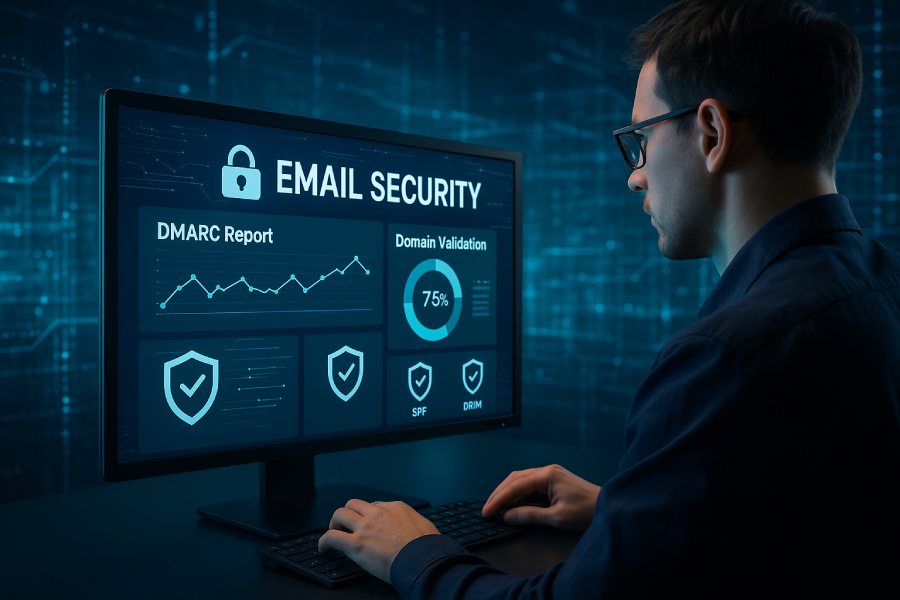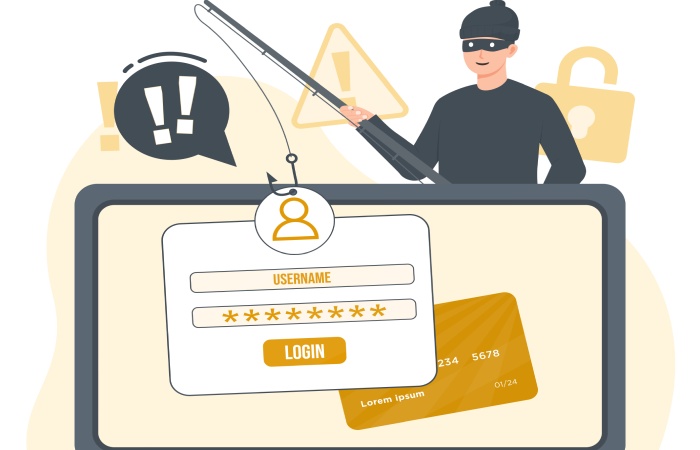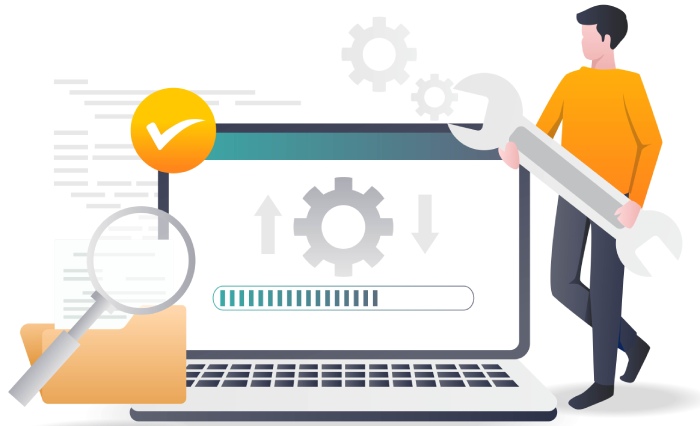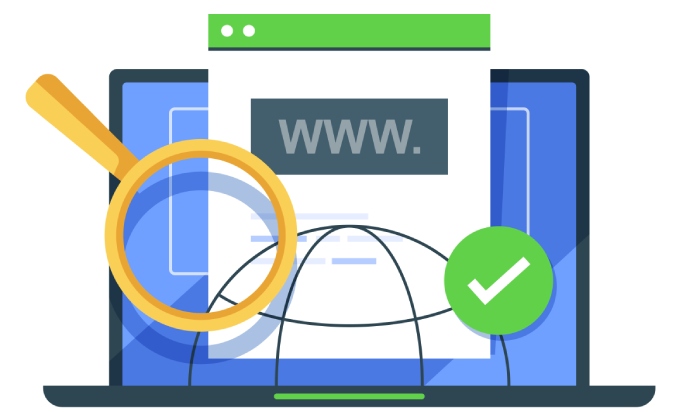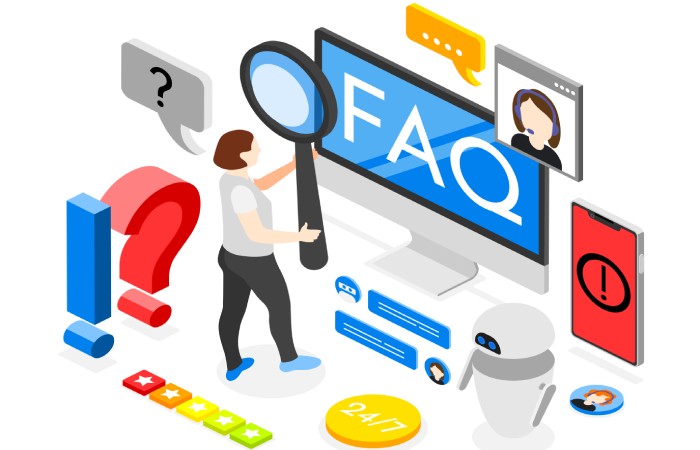In today’s digital landscape, ensuring robust email security is paramount for organizations and domain owners alike. The rise of email phishing attacks, domain spoofing, and other forms of email fraud necessitates advanced solutions that not only detect but also prevent unauthorized email activity.
Domain-based Message Authentication, Reporting & Conformance (DMARC) stands as a critical protocol in the arsenal of email security best practices. This protocol, when correctly implemented and monitored, combats email spoofing and bolsters email deliverability through a structured email authentication framework.
This article explores the essentials of DMARC, its protective roles against phishing and spoofing, the key components of DMARC records, challenges in implementation, and an overview of the most effective instant test DMARC tools available today.
Understanding DMARC: What It Is and Why It Matters
DMARC is an email authentication standard designed to give domain owners greater control over their email domains by specifying how email receivers should handle authentication failures related to SPF (Sender Policy Framework) and DKIM (DomainKeys Identified Mail). At its core, DMARC is a policy layer that builds on these underlying protocols to enforce proper domain alignment and prevent unauthorized use of the domain name in email headers.
Email authentication protocols like SPF define authorized mail servers through DNS TXT records containing specific sender policy framework information, while DKIM adds cryptographic signatures to email headers, allowing recipients to verify message authenticity and integrity. DMARC bridges these by setting a DMARC policy—commonly configured as “none,” “quarantine,” or “reject”—to direct mail servers and email security gateways on handling mails that fail SPF and DKIM checks.
The significance of DMARC lies in its ability to mitigate phishing and spoofing threats by empowering domain owners with domain verification and email policy enforcement capabilities. It enhances domain reputation and cultivates trust with email recipients, thereby improving email deliverability.
How DMARC Protects Your Domain from Email Spoofing and Phishing
Email spoofing is a prevalent form of cyberattack where malicious actors forge email headers to impersonate trusted domains, facilitating phishing or other fraudulent activities. DMARC combats this by demanding domain alignment — the condition that the “From” header domain aligns with authenticated domains validated by SPF and DKIM.
When an email passes SPF or DKIM authentication and aligns with the domain in the “From” header, DMARC considers the email legitimate. If not, the domain owner’s DMARC policy governs the receiving mail transfer agent (MTA) or SMTP server’s response, offering robust email spoofing prevention. For example, under a “reject” policy, unauthorized emails are blocked outright, dramatically reducing successful phishing attempts and domain spoofing.
Moreover, the DMARC reporting mechanism, through aggregate reports and forensic reports, arms domain owners and postmasters with threat intelligence. These reports detail authentication results, highlight suspicious activity, and provide insights into possible email fraud detection and phishing mitigation, supporting ongoing email compliance and improvements in email security protocols.
Key Components of DMARC Records and Their Functions
A DMARC record is a specialized DNS TXT record published under the domain owner’s DNS management system. It contains several critical tags that define the DMARC policy and reporting preferences:
- v=DMARC1: Identifies the record as a DMARC record.
- p=policy: Sets the primary policy for how to handle emails that fail authentication tests.
Common policies include:
- none policy: Monitor only, no enforcement.
- quarantine policy: Direct failed emails to spam/junk folders.
- reject policy: Block failed emails outright for maximum enforcement.
- rua=mailto:: Defines addresses to send DMARC aggregate reports.
- ruf=mailto:: Specifies where forensic reports (detailed failure reports) go.
- pct=percentage: Specifies the percentage of emails subjected to the policy.
Additionally, domain alignment parameters—such as relaxed or strict modes—govern how strictly domains must match between SPF, DKIM, and the “From” header. This helps fine-tune email fraud prevention without disrupting legitimate email flows.
Properly configured DMARC records aid in email security best practices by helping email security gateways, such as those from Cisco, Microsoft, or Barracuda Networks, to implement consistent email authentication standards. Furthermore, mail server configuration must accommodate these policies to ensure enforcement via SMTP.
Common Challenges in Implementing DMARC
Despite its effectiveness, DMARC implementation poses several challenges for domain owners:
Complexity of SPF and DKIM Setup:
Effective DMARC enforcement depends on correctly configuring SPF and DKIM records across various sending infrastructures, including third-party services like Amazon SES, SendGrid, or Google Workspace. Misconfigurations can lead to false positives, negatively impacting email deliverability.
DNS Management Issues:
Publishing and maintaining accurate DNS TXT records for DMARC requires expertise in DNS management. Changes can take time to propagate, complicating timely DMARC enforcement.
Handling Legitimate Forwarding or Mailing Lists:
Forwarded emails often fail SPF due to IP mismatches, raising false alarms and necessitating careful calibration of DMARC policies (e.g., easing strictness with a “quarantine” or “none” policy initially).
Interpreting DMARC Reports:
Aggregate and forensic reports can be voluminous and complex. Tools like DMARC analyzer or platforms from Proofpoint and Agari assist postmasters with automated parsing, but domain owners may still find report analysis challenging.
Balancing Enforcement and Deliverability:
Strict reject policies bolster security but risk blocking legitimate emails during early stages. Gradual policy alignment and monitoring through none and quarantine policies, supported by robust reporting mechanisms, are recommended.
Overview of Instant Test DMARC Tools Available in the Market
As DMARC adoption grows, several instant test DMARC tools have emerged to simplify DMARC implementation, validation, and ongoing monitoring. These tools enable domain owners and IT teams to instantly validate DMARC records, verify domain alignment, and assess email authentication settings. Leading solutions combine DMARC analyzers, threat intelligence integration, and user-friendly dashboards:
- Duocircle: A reliable email security service offering advanced phishing protection, email forwarding, and SMTP relay solutions. It enhances domain security with DMARC, SPF, and DKIM support, while providing spam filtering and protection against email spoofing for improved message delivery and trust.
- Dmarcian: A comprehensive service that provides detailed DMARC reports, forensic analysis, and policy recommendation using its DMARC testing tools. It supports domain verification and mail server configuration checks.
- EasyDMARC: Known for an intuitive interface that helps visualize DMARC compliance and email deliverability metrics. Magic links to DNS management facilitate record adjustments.
- OnDMARC by Red Sift: Focuses on DMARC implementation automation and provides actionable insights into domain spoofing and email fraud prevention.
- DMARC Analyzer: This platform leverages powerful filters on DMARC aggregate reports and forensic reports, offering real-time threat intelligence and phishing mitigation.
- Valimail: Supports automated email authentication protocols enforcement within complex corporate environments, emphasizing email policy enforcement.
- Google Postmaster Tools: Ideal for Google-powered domains, offering insights into domain reputation, DMARC policy effectiveness, and spam filtering performance.
- 250ok: Offers robust DMARC, SPF, and DKIM analytics with integrations to popular mail services including Mimecast and Trend Micro, focusing on email authentication standards and email fraud detection.
- Third-Party Platforms like Cisco, Proofpoint, Barracuda Networks, and Trend Micro: Many email security gateways from these vendors incorporate integrated DMARC monitoring and enforcement, alongside email encryption and threat intelligence to maximize anti-phishing posture.
For domain owners looking for web-based DX solutions, DuoCircle provides instant test DMARC tools that simplify domain verification, email policy enforcement, and provide thorough DMARC records guidance. Its offerings extend into email security services, reinforcing domain spoofing defense with real-time DMARC policy analysis.
Instant test DMARC tools lead the effort in bridging the gap between mail transfer agent configurations, sender policy framework setup, and post-delivery reporting, enabling domain owners to manage domain-based message authentication efficiently. They play a pivotal role in global phishing mitigation strategies by giving actionable analytics that refine email security protocols and optimize email compliance across organizations of all sizes.
Statistical Data: DMARC Adoption and Email Security Impact
- Global DMARC domain adoption increased by over 60% in the past 3 years
- Over 80% of enterprises have reduced successful email phishing attacks post-DMARC implementation
- Approximately 70% of domains now enforce quarantine or reject policies to prevent email spoofing
- Domains with strict DMARC policies report a 45% increase in email deliverability and improved domain reputation
- Over 30% of DMARC aggregate reports indicate misuse by external actors, highlighting widespread phishing attempts
Source: DMARC.org annual security reports, Google Postmaster Tools analytics
Step-by-Step Guide to Using Instant Test DMARC Tools
Implementing a robust DMARC record is critical for domain owners aiming to enhance email security and prevent email spoofing and phishing attacks. Instant test DMARC tools provide a streamlined approach to verify the correctness of DMARC records, assess domain-based message authentication, and ensure adherence to email authentication standards such as SPF and DKIM. Here’s a stepwise process:
- Access a Reliable DMARC Testing Tool: Popular platforms like Dmarcian, EasyDMARC, and OnDMARC offer instant test DMARC interfaces. Additionally, tools like Google Postmaster Tools and DMARC.org provide valuable resources for domain verification and DMARC implementation checks.
- Enter Your Domain Name: Input the domain for which you wish to test the DMARC record. The tool queries the DNS TXT record where the DMARC policy resides and retrieves the current DMARC record configuration.
- Analyze the DMARC Record Syntax and Policy: The tool parses the DMARC policy (none policy, quarantine policy, or reject policy) set within the DNS TXT record. It verifies domain alignment with SPF and DKIM, which is essential to achieving strict email compliance.
- Review the Aggregate and Forensic Reporting Mechanism: Instant test DMARC tools will check whether aggregate reports (RUA) and forensic reports (RUF) email addresses are correctly configured, enabling a mail transfer agent or postmaster to receive critical threat intelligence on email fraud detection and phishing mitigation.
- Test for Email Spoofing and Security Gaps: Some advanced analyzers provide simulation environments or test email headers to validate how mail servers process inbound SMTP transmissions under the current DMARC policy.
- Generate a DMARC Report: The tool offers insights on domain reputation, email deliverability, and policy enforcement. This data assists in refining email security best practices to enhance your domain’s defense against email phishing attacks.
By following these steps, domain owners can confirm domain verification and ensure the optimal mail server configuration to uphold email security protocols and anti-phishing measures.
Interpreting the Results from DMARC Testing Tools
Understanding the output from instant test DMARC tools is crucial for effective domain-based message authentication and email fraud prevention.
DMARC Policy Verification:
The tool will indicate whether your DMARC policy utilizes ‘none,’ ‘quarantine,’ or ‘reject.’ A ‘none policy’ offers monitoring without enforcement, while ‘quarantine’ diverts suspicious emails to spam folders, and ‘reject’ strictly refuses emails failing DMARC checks, providing maximum email spoofing prevention.
SPF and DKIM Alignment:
Results highlight the domain alignment status between SPF records and DKIM signatures. Proper domain alignment confirms that emails originate from authorized mail transfer agents (MTAs) and are cryptographically signed, ensuring email headers align with the domain owner’s policy.
DNS TXT Record Status:
The tool checks for syntax errors or missing tags in the DNS TXT record, essential for effective DMARC implementation. Incorrect DNS management can cause misinterpretation by receiving SMTP servers.
Reporting Addresses Validity:
Whether DMARC aggregate reports and forensic reports are routed correctly to postmasters or email security gateways is assessed. Failure to receive these reports can limit visibility into phishing mitigation effectiveness.
Domain Reputation and Deliverability Insights:
Some advanced platforms from vendors like Proofpoint and Valimail provide detailed analytics on domain reputation, identifying if email deliverability is being impacted by stringent email policy enforcement.
By carefully interpreting these details, organizations can refine their DMARC record, tighten email authentication standards, and reduce the likelihood of domain spoofing.
Best Practices to Improve DMARC Alignment and Policy Enforcement
Ensuring your DMARC record achieves optimal email security requires adherence to best practices regarding domain alignment and policy enforcement.
- Start with a ‘None’ Policy for Monitoring: Initially deploying a ‘none policy’ allows collection of DMARC aggregate reports without impacting email deliverability, helping domain owners understand their email flow and any unauthorized sources.
- Implement Robust SPF and DKIM Records: Configure SPF with the correct sender policy framework and ensure DKIM signatures are applied by all mail servers. This dual-layered authentication strengthens domain alignment integrity.
- Gradually Shift to Quarantine and Reject Policies: Once confidence in email authentication is established via forensic reports and DMARC analyzer feedback, transition to ‘quarantine’ and eventually ‘reject’ policies for strict enforcement against email spoofing.
- Regularly Monitor DMARC Reports Using Analytics Tools: Leveraging threat intelligence platforms such as Trend Micro, Cisco, or Barracuda Networks enhances the analysis of email phishing attacks and domain spoofing attempts.
- Maintain Accurate DNS Management: Timely updates to DNS TXT records and alignment with domain verification results prevent policy misconfigurations that can lead to email delivery failures.
- Coordinate with Email Service Providers: Collaboration with providers like Google, Microsoft, Amazon SES, SendGrid, and Cloudflare ensures that mail transfer agents and SMTP configurations align with DMARC policies.
Implementing these strategies aligns with email security best practices and supports effective email fraud detection and phishing mitigation.
Case Studies: Successful Domain Protection Using Instant Test DMARC Tools
Several organizations have leveraged instant test DMARC tools to significantly bolster their email security posture and combat phishing.
Tech Giant Case – Facebook:
By employing DMARC.org guidelines and integrating DMARC testing tools alongside SPF and DKIM implementations, Facebook achieved enhanced domain spoofing prevention. Their postmaster team noted improved domain reputation and a substantial decrease in email spoofing attempts targeting users.
Enterprise Adoption – Google Workspace and Microsoft 365:
Both Google and Microsoft recommend DMARC implementation as part of email authentication standards. Utilizing Google Postmaster Tools and Microsoft Defender for Office 365, enterprises achieved superior email deliverability while efficiently blocking phishing attacks through enforced reject policies and comprehensive forensic reporting.
SMB Success Story – E-commerce Retailer:
Using EasyDMARC and OnDMARC tools, the company established robust DNS TXT records and migrated from none to quarantine DMARC policy, reducing email fraud by 70%. Real-time DMARC aggregate reports facilitated proactive email security gateway adjustments aligned with SMTP best practices.
These use cases illustrate how integrating instant test DMARC tools into mail server configuration and DNS management contributes to effective email policy enforcement and strengthens overall email security frameworks.
Future Trends in Email Authentication and DMARC Testing
As cyber threats evolve, so do email authentication technologies and DMARC testing methodologies.
- Enhanced Machine Learning for Threat Intelligence: Platforms such as Valimail and Proofpoint are embedding AI-driven analytics within DMARC analyzer tools to detect email phishing attacks with greater accuracy and predict emerging spoofing tactics.
- Adoption of BIMI (Brand Indicators for Message Identification): BIMI builds on existing DMARC policies, enabling brand logos within authenticated emails, further mitigating phishing by enhancing domain trust signals.
- Integration with Email Security Gateways: Comprehensive email security solutions from Mimecast, Cisco, and Barracuda Networks will embed real-time DMARC verification as part of a multi-layer defense strategy, harmonizing email encryption and policy enforcement.
- Improved Forensic Reporting Standards: Industry bodies like DMARC.org anticipate enhanced reporting mechanisms to provide granular insights into email fraud detection, aiding domain owners and postmasters in rapid incident response.
- Automation of DNS Management and Policy Updates: Tools such as SolarWinds and 250ok are developing automation to streamline DNS TXT record updates, SPF record adjustments, and DKIM key rotations, ensuring continuous compliance with evolving email authentication standards.
These advancements illustrate that DMARC testing tools remain vital in proactive email security, maintaining domain alignment, and combating the persistent threat of email spoofing and phishing.
FAQs
What is the importance of DMARC in email authentication?
DMARC helps prevent email spoofing and phishing by enforcing domain-based message authentication via SPF and DKIM. It ensures that unauthorized senders cannot impersonate your domain, thereby improving email security and domain reputation.
How do SPF and DKIM work with DMARC?
SPF defines which mail servers can send emails on behalf of a domain, while DKIM adds a cryptographic signature to email headers. DMARC requires alignment of these protocols with the domain to verify message authenticity, enabling effective email fraud prevention.
What are the differences between DMARC policies: none, quarantine, and reject?
A ‘none’ policy monitors without impact, ‘quarantine’ sends suspicious emails to spam/junk folders, and ‘reject’ outright denies non-compliant emails. Gradual enforcement from none to reject optimizes email deliverability while increasing security.
How can I use DMARC aggregate and forensic reports?
Aggregate reports provide overall statistics on authentication results, while forensic reports give detailed data on individual failed emails. Together, they offer valuable threat intelligence for domain owners to detect and mitigate email phishing attacks.
Are there recommended tools for DMARC implementation and testing?
Yes, tools such as EasyDMARC, OnDMARC, Dmarcian, and Google Postmaster Tools provide comprehensive testing, analysis, and reporting capabilities to streamline DMARC implementation and ensure continuous email compliance.
How does DMARC improve email deliverability?
By authenticating emails reliably, DMARC enhances domain reputation with receiving mail servers and reduces the chances of legitimate emails being marked as spam, thus improving overall email deliverability.
Key Takeaways
- Proper DMARC record configuration with aligned SPF and DKIM is essential for preventing email spoofing and enhancing email security.
- Instant test DMARC tools help domain owners verify DNS TXT records, analyze policies, and receive critical reports for email fraud detection.
- Gradual policy enforcement from none to reject policies, combined with continuous monitoring of DMARC aggregate and forensic reports, ensures effective phishing mitigation.
- Collaboration with major email service providers and use of advanced DMARC analyzers empower organizations to maintain domain reputation and maximize email deliverability.
- Emerging trends in DMARC testing involve AI-driven threat intelligence, automated DNS management, and integration with comprehensive email security gateways for future-ready email protection.
